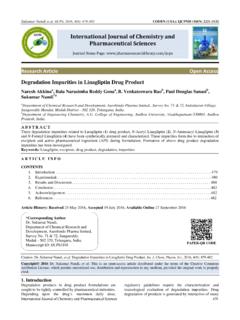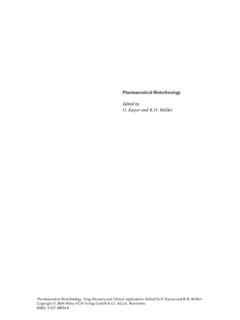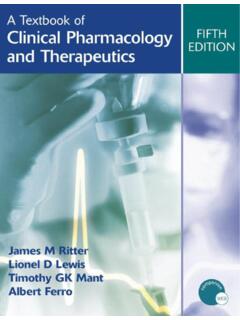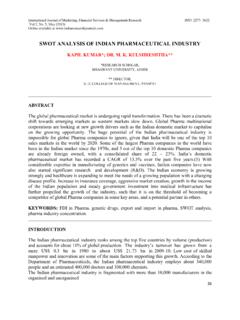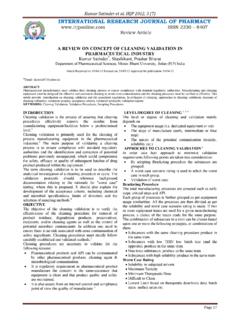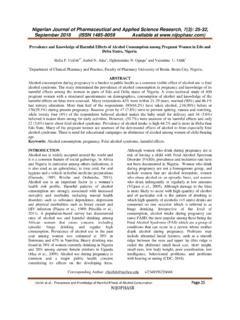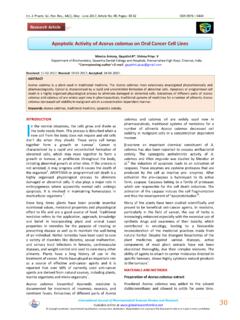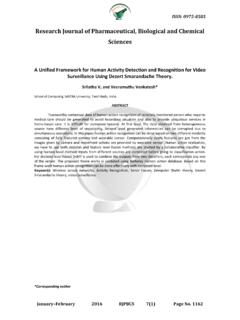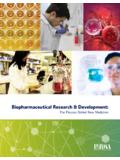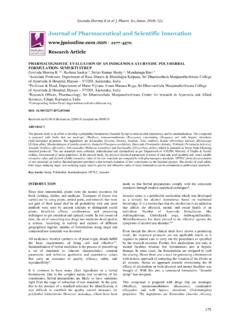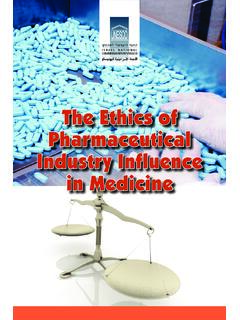Transcription of Journal of Pharmaceutical and Biological Research
1 G. Harikaet al,JPBR,2015, 3(2):294 300 ISSN:2347-8330 Journal of Pharmaceuticaland Biological Research294 Journal of Pharmaceutical andBiological ResearchJournal Home ArticleOpen AccessEvaluation of Antidiabetic Activity of Ethanolic Extract ofPolyalthia SuberosaRothin Alloxan Induced Diabetic RatesG. Harika*1, Dr. G. Nagarjuna Reddy2, Rajani Gunnam3, Dr. Suresh4,G. Sravanthi41 Research Scholar,KLR Pharmacy College, Paloncha, Khammam, Telangana, India2 Department of Pharmaceutical Chemistry,KLR Pharmacy College, Paloncha, Khammam, Telangana, India3 Department of Pharmacy Practice,KLR Pharmacy College, Paloncha, Khammam, Telangana, India4 Department of Pharmacology,KLR Pharmacy College, Paloncha, Khammam, Telangana, IndiaA B S T R A C TThe ethanolic leaf extract ofPolyalthia suberosa(EEPS) was tested for its anti-diabetic activity by normoglycaemic plusglucose fed hyperglycaemicrats (NG-OGTT) method, and sub acute treatment methods in alloxan-induced diabetic rats.
2 InNG-OGTT, Blood glucose levels were determined after oral administration of two concentrations of EEPS (200 and 400mg/kg) at specific time intervals. In sub acutetreatment method, Blood glucose levels were determined after oraladministration of two concentrations of EEPS (200 and 400 mg/kg) at 0th,10thand 15thday and biochemical parameters likeserum protein, serum creatinine and lipid profile were estimated after 14 days of sub acute study. Glibenclamide ( mg/kg)was taken as a standard reference. The results revealed that EEPS at a dose level of 400 mg/kg exhibit significant (p< )hypoglycaemic effect in NG-OGTT model compared to low dose level of200 mg/kg (p< ). In acute treatment method,both the concentrations of EEPS showed significant (p< ) hypoglycaemic effect. In sub acute treatedgroupsadministrationof a low dose of 200 mg/kg reduced blood glucose level with less significance (p< ) but a high dose of400 mg/kg reduced blood glucose significantly (p< ).
3 In addition, changes in body weight, serum protein, serumcreatinine and serum lipid profile levels assessed in the extract treated diabetic rats were compared with standard control,diabetic control and normal animals in sub acute treated groups. Significant results were observed in the estimated parametersfurther recommended to evaluate EEPS for its long standing anti-diabetic effect and the molecular mechanism for its anti-diabetic activity thereby justifying the use of the plant in the indigenous system of :Polyalthia suberosa,NG-OGTT,Antidiabetic activity, R T I C L EI N F .. and Methods .. and discussion ..299 ArticleHistory:Received25 September2015,Accepted18 November2015,Available Online21 December2015 PAPER-QR CODE*Corresponding AuthorG. HarikaResearch Scholar,KLR Pharmacy College, Paloncha,Khammam, Telangana, IndiaManuscript ID:JPBR2819G.
4 Harikaet al,JPBR,2015, 3(2):294 300 ISSN:2347-8330 Journal of Pharmaceuticaland Biological Research294 Journal of Pharmaceutical andBiological ResearchJournal Home ArticleOpen AccessEvaluation of Antidiabetic Activity of Ethanolic Extract ofPolyalthia SuberosaRothin Alloxan Induced Diabetic RatesG. Harika*1, Dr. G. Nagarjuna Reddy2, Rajani Gunnam3, Dr. Suresh4,G. Sravanthi41 Research Scholar,KLR Pharmacy College, Paloncha, Khammam, Telangana, India2 Department of Pharmaceutical Chemistry,KLR Pharmacy College, Paloncha, Khammam, Telangana, India3 Department of Pharmacy Practice,KLR Pharmacy College, Paloncha, Khammam, Telangana, India4 Department of Pharmacology,KLR Pharmacy College, Paloncha, Khammam, Telangana, IndiaA B S T R A C TThe ethanolic leaf extract ofPolyalthia suberosa(EEPS) was tested for its anti-diabetic activity by normoglycaemic plusglucose fed hyperglycaemicrats (NG-OGTT) method, and sub acute treatment methods in alloxan-induced diabetic rats.
5 InNG-OGTT, Blood glucose levels were determined after oral administration of two concentrations of EEPS (200 and 400mg/kg) at specific time intervals. In sub acutetreatment method, Blood glucose levels were determined after oraladministration of two concentrations of EEPS (200 and 400 mg/kg) at 0th,10thand 15thday and biochemical parameters likeserum protein, serum creatinine and lipid profile were estimated after 14 days of sub acute study. Glibenclamide ( mg/kg)was taken as a standard reference. The results revealed that EEPS at a dose level of 400 mg/kg exhibit significant (p< )hypoglycaemic effect in NG-OGTT model compared to low dose level of200 mg/kg (p< ). In acute treatment method,both the concentrations of EEPS showed significant (p< ) hypoglycaemic effect. In sub acute treatedgroupsadministrationof a low dose of 200 mg/kg reduced blood glucose level with less significance (p< ) but a high dose of400 mg/kg reduced blood glucose significantly (p< ).
6 In addition, changes in body weight, serum protein, serumcreatinine and serum lipid profile levels assessed in the extract treated diabetic rats were compared with standard control,diabetic control and normal animals in sub acute treated groups. Significant results were observed in the estimated parametersfurther recommended to evaluate EEPS for its long standing anti-diabetic effect and the molecular mechanism for its anti-diabetic activity thereby justifying the use of the plant in the indigenous system of :Polyalthia suberosa,NG-OGTT,Antidiabetic activity, R T I C L EI N F .. and Methods .. and discussion ..299 ArticleHistory:Received25 September2015,Accepted18 November2015,Available Online21 December2015 PAPER-QR CODE*Corresponding AuthorG. HarikaResearch Scholar,KLR Pharmacy College, Paloncha,Khammam, Telangana, IndiaManuscript ID:JPBR2819G.
7 Harikaet al,JPBR,2015, 3(2):294 300 ISSN:2347-8330 Journal of Pharmaceuticaland Biological Research294 Journal of Pharmaceutical andBiological ResearchJournal Home ArticleOpen AccessEvaluation of Antidiabetic Activity of Ethanolic Extract ofPolyalthia SuberosaRothin Alloxan Induced Diabetic RatesG. Harika*1, Dr. G. Nagarjuna Reddy2, Rajani Gunnam3, Dr. Suresh4,G. Sravanthi41 Research Scholar,KLR Pharmacy College, Paloncha, Khammam, Telangana, India2 Department of Pharmaceutical Chemistry,KLR Pharmacy College, Paloncha, Khammam, Telangana, India3 Department of Pharmacy Practice,KLR Pharmacy College, Paloncha, Khammam, Telangana, India4 Department of Pharmacology,KLR Pharmacy College, Paloncha, Khammam, Telangana, IndiaA B S T R A C TThe ethanolic leaf extract ofPolyalthia suberosa(EEPS) was tested for its anti-diabetic activity by normoglycaemic plusglucose fed hyperglycaemicrats (NG-OGTT) method, and sub acute treatment methods in alloxan-induced diabetic rats.
8 InNG-OGTT, Blood glucose levels were determined after oral administration of two concentrations of EEPS (200 and 400mg/kg) at specific time intervals. In sub acutetreatment method, Blood glucose levels were determined after oraladministration of two concentrations of EEPS (200 and 400 mg/kg) at 0th,10thand 15thday and biochemical parameters likeserum protein, serum creatinine and lipid profile were estimated after 14 days of sub acute study. Glibenclamide ( mg/kg)was taken as a standard reference. The results revealed that EEPS at a dose level of 400 mg/kg exhibit significant (p< )hypoglycaemic effect in NG-OGTT model compared to low dose level of200 mg/kg (p< ). In acute treatment method,both the concentrations of EEPS showed significant (p< ) hypoglycaemic effect. In sub acute treatedgroupsadministrationof a low dose of 200 mg/kg reduced blood glucose level with less significance (p< ) but a high dose of400 mg/kg reduced blood glucose significantly (p< ).
9 In addition, changes in body weight, serum protein, serumcreatinine and serum lipid profile levels assessed in the extract treated diabetic rats were compared with standard control,diabetic control and normal animals in sub acute treated groups. Significant results were observed in the estimated parametersfurther recommended to evaluate EEPS for its long standing anti-diabetic effect and the molecular mechanism for its anti-diabetic activity thereby justifying the use of the plant in the indigenous system of :Polyalthia suberosa,NG-OGTT,Antidiabetic activity, R T I C L EI N F .. and Methods .. and discussion ..299 ArticleHistory:Received25 September2015,Accepted18 November2015,Available Online21 December2015 PAPER-QR CODE*Corresponding AuthorG. HarikaResearch Scholar,KLR Pharmacy College, Paloncha,Khammam, Telangana, IndiaManuscript ID:JPBR2819G.
10 Harikaet al,JPBR,2015, 3(2):294 300 ISSN:2347-8330 Journal of Pharmaceuticaland Biological Research295 Citation:G. Harika,et of Antidiabetic Activity of Ethanolic Extract of Polyalthia Suberosa Roth in Alloxan InducedDiabetic Pharm. ,2015,3(2) 2015G. Harika,et is an open-access article distributed under the terms of the Creative Commons Attribution License,which permits unrestricted use, distribution and reproduction in any medium, provided theoriginal work is properly IntroductionDiabetes mellitus (DM) is the most common endocrinedisorder. It affects more than 100 million people worldwideand its incidence is increasing steadily with changes in lifestyles [1]. It is not a single disease entity, but rather a groupof metabolic disorders sharing the common underlyingfeature of hyperglycemia. Approximately 50% of diabeticcases can be adequately controlled by diet alone, 20-30%will need an oral anti diabetic medication and 20-30% willrequire insulin [2].
